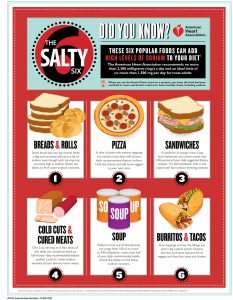
Many Americans consume too much dietary sodium. This can increase their blood pressure leading to hypertension, heart disease, stroke, kidney disease, and blindness. While sodium is an essential nutrient needed to sustain life, the long-standing recommendation to reduce excess sodium in the diet is still a challenge for many people. Most Americans consume an average of more than 3,400 milligrams of sodium daily. The 2015 – 2020 Dietary Guidelines recommend daily dietary sodium intake for adults should not exceed 2,300 milligrams.
So where is all the dietary sodium coming from considering most foods are naturally low in sodium? Dietary sodium is found most abundantly in sodium chloride, which is common table salt. Sodium chloride is about 40% sodium and 60% chloride.
Salt As a Preservative
Historically, the main use for salt was as a preservative due to sodium’s ability to retard the growth of harmful microorganisms. In addition to preservation, salt is commonly used in the food manufacturing industry to enhance flavor, texture, and appearance of food. It is also part of many food processes including fermentation, emulsification, and leavening. The result of the food industry’s extensive use of salt and sodium-based compounds has contributed to high levels of sodium in the American diet. Click here to visit the Centers for Disease Control and Prevention website to learn more about sodium’s role in processed foods.
Traditionally, our main source of dietary sodium has been from salt added directly to food while cooking and at the table. With the advent of processed foods, most Americans consume about 75% of their sodium from processed, prepared, and restaurant foods. However, it is the total sodium in our food that we need to better manage, regardless of its source.
Are You Serious About Reducing Sodium?
If you are serious about reducing sodium in your diet, take a closer look at the foods you typically eat and find a healthier version or replace with another choice. There is an abundance of resources available to help you find the amount of sodium in almost any food from a plain apple to pepperoni pizza. Common resources available include the Nutrition Facts label and on-line nutrition information from food manufacturers and restaurants. Additionally, the USDA Nutrient Database provides a comprehensive nutrition profile for an extensive inventory of raw and processed foods.
The Food and Drug Administration has categorized five sodium claims that can be used on the Nutrition Facts label. Click here to visit the Food and Drug Administration website to learn more about sodium in your diet and how to use the Nutrition Facts label to reduce your intake.
Food Label Claims
What the Terms Really Mean
| Salt/Sodium-Free | Less than 5 mg of sodium per serving |
| Very Low Sodium | 35 mg of sodium or less per serving |
| Low Sodium | 140 mg of sodium or less per serving |
| Reduced Sodium | At least 25% less sodium than in the original product |
| Light in Sodium or Lightly Salted | At least 50% less sodium than the regular product |
| No-Salt-Added or Unsalted | No salt is added during processing. |
Reference: Food Facts: Sodium in Your Diet - Use the Nutrition Facts Label and Reduce Your Intake - Food and Drug Administration
Click here to visit the University of Florida Extension Service EDIS website to learn more about sodium in your diet and how to shop for lower-sodium foods.
Click on the chart below to learn what the American Heart Association considers six popular foods that add the highest levels of sodium to your diet.

 0
0
